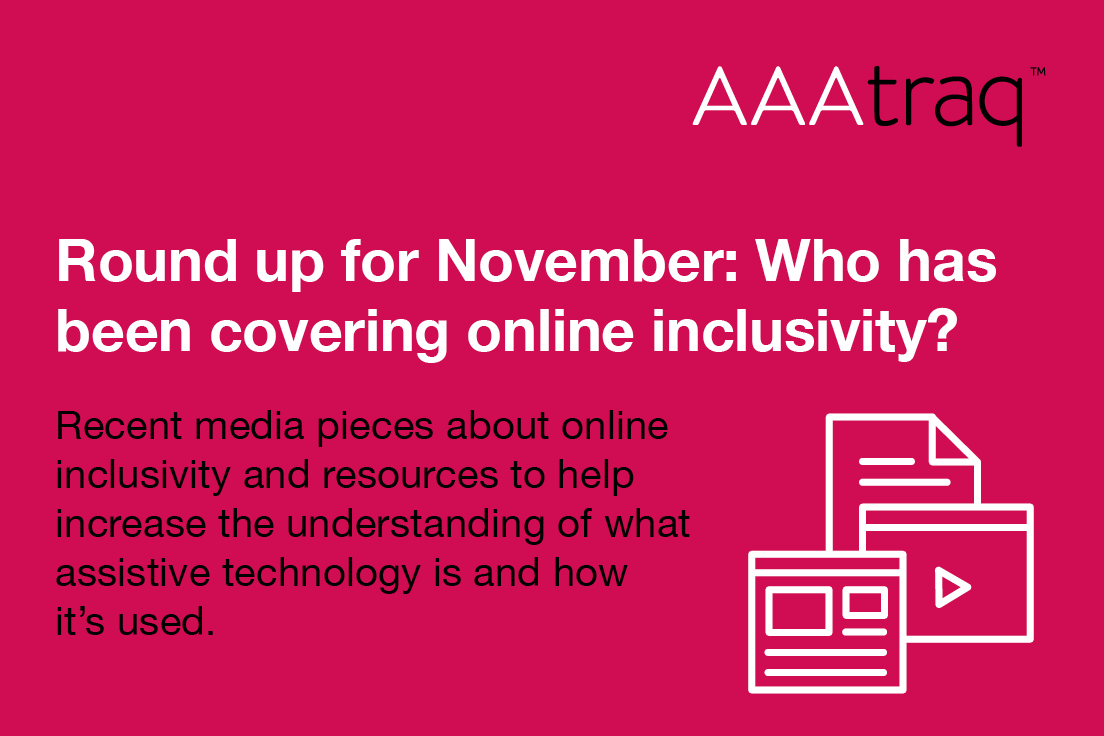Round up for November, who has been covering online inclusivity?
Nov 24 2021
The last month has continued to bring us big stories on digital inclusion. We’ve seen articles focusing on different aspects such as eBooks and captions in the theatre industry, showing just how wide the topic of digital inclusion really is.
As always, we’ve compiled some notable pieces about online inclusivity from the past few weeks. There is some good news on progress being made in several areas including, vaccine booking; the banking industry; and mobile phones. In addition, there’s more talk about the use of overlays.
How Online Shopping Is Excluding the Disabled Consumer
This article gives a first-hand account of a legally blind woman’s experience of online shopping. Natalie highlights her frustration with non-compliant websites and how online shopping platforms such as Shopify need to also take responsibility.
AMC bringing captions to big screens across the country
Some very welcome news for those who are deaf and hard of hearing as 240 theaters get open captioning (dialogue and audio that appears on the screen). This is great news; however, this only covers around 40% of the company’s US theaters, we hope the other theatres will get this initiative in the near future.
https://www.washingtonpost.com/business/2021/10/20/amc-open-captions/ (opens in a new window)
Blind People Won the Right to Break Ebook DRM. In 3 Years, They'll Have to Do It Again
In this piece, the topic of inclusivity in eBooks is discussed along with the issues around copyright law – highlighting how much of an afterthought inclusivity continues to be in eBook technology.
https://www.wired.com/story/ebooks-drm-blind-accessibility-dmca/ (opens in a new window)
Why Automated Tools Alone Can’t Make Your Website Accessible And Legally Compliant
The issues with overlays hasn’t stopped making the headlines. This article focuses on why organizations should not rely on such technologies and delves into the technicalities of some recent ADA non-compliance cases where overlays had been used.
Justice Department Secures Agreement with Rite Aid Corporation to Make Its Online COVID-19 Vaccine Registration Portal Accessible to Individuals with Disabilities
Some progress is being made with making COVID-19 vaccines inclusive. It’s been acknowledged that the Rite Aid’s COVID-19 Vaccine Registration Portal was not accessible to some people with disabilities, including those who use screen reader software and those who have a hard time using a mouse. Rite Aid now must now make their content complaint to WCAG 2.1, regularly test their pages and remediate any issues found. We will be interested to see how closely Rite Aid follow this.
Overlays Underwhelm: Web Directions AAA 2021
This is a collection of images, videos, tweets, articles, and links referenced in a talk for Web Directions AAA 2021 by Adrian Roselli. This is possibly one of the most thorough capabilities review of overlays we’ve seen including the dangers, pitfalls, and reality of a promise of a 'quick fix’. Anyone considering using an overlay should read this.
The Pixel 6's Accessibility Features Make Me Hopeful for the Future of Smartphones
Another area progress is being made in, but we should make it clear that these devices are still not perfect. However, the improved voice recognition, new gesture controls and a more inclusive interface are helping to narrow the gap between experiences for people living with disabilities and those who are not.
TD Bank integrates blind, low-vision technology into all branches
Another positive move as TD Bank has integrated Aira, a technology meant to serve blind and low-vision customers, in all of its US locations (more than 1,100). The technology connects individuals to remote visual interpreters and navigators who use livestream video to translate visual information into descriptive audio.
Subscribe to AAAtraq and enjoy complete cover and peace of mind
